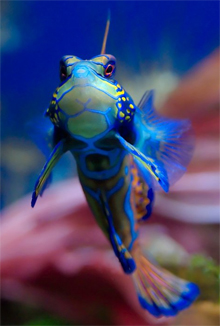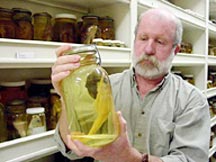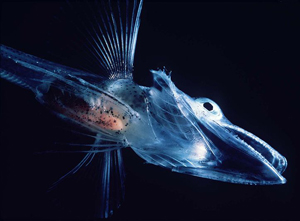More than 27,000 types and counting
Kinds of Fishes
| • | See the unusual and familiar. Find out how fishes are identified, named and related. |
| • | Find out about body parts both inside and out. |
| • | See how anatomy relates to lifestyle. |
| • | Learn about the fishes we consume. |
The aquatic wilderness


 Mandarinfish
Mandarinfishor Mandarin Dragonet
Synchiropus splendidus. The tiny but flamboyant Mandarinfish is a popular aquarium fish that's not much bigger than an unshelled peanut. It lives in reefs of the western Pacific. Preferential collection of males may threaten these fish in the wild by altering the structure of their populations. Aquarists who successfully breed such fish in captivity can play a role in conservation and developing greater understanding of habitat requirements. Mandarinfish in aquarium-Muséum Liège (Belgium). Photographer - Luc Viatour,
Creative Commons ShareAlike 3.0.
Fishes come in an impressive variety of sizes and shapes that hold the living machinery of remarkable bodies.
More than 27,000 species of living fishes and the fossil remains of many others are known. Whether living or extinct, observations suggest that all of these fishes are the descendants of a single first fish that lived over 530 million years ago. Through transformation and elimination, by evolution, primitive forms became the species we see today.
Over hundreds of millions of years fishes were confronted by a progression of conditions on Earth. Circumstances changed as tectonic plates shifted. Entire oceans and ice sheets came-and-went. Some anatomical features that had been critcally advantageous became less so, while the utility of some features endured. Luck played a part too — having the right anatomy at the right time. All along, new competitors bearing ever newer anatomical weapons appeared.
The fishes that live today are a snapshot along a progression of life on Earth. Today they face accelerated change brought on by a new and radically different predator - humans who reach out from land.
"Kinds of Fishes" introduces you to nearly half of all living vertebrates on Earth. It covers the diversity of fishes and the rationale for classification. It gives you a sense of the complex interdependencies that exist between anatomy, lifestyle, and success of species. It closes with an introduction to the fishes we consume, associated problems, and our uniquely human social response, i.e., to try and shape the future by choosing to balance the interests of consumption and preservation.
The relationship with humans show
The value of knowing more about fishes show
The Marine Vertebrate Collection at Scripps Institution of Oceanography
More than 2 million specimens of fish representing 5,600 different species are preserved in the The Marine Vertebrate Collection at Scripps Institution of Oceanography. Some have been preserved since they were collected on expeditions nearly a century ago. The Collection includes type specimens that are the standard by which a particular species of fish is identified. A single specimen preserved in the Collection may be the only known specimen in the world.

The Collection is housed on the Scripps campus at the University of California at San Diego where thousands of jars of preserved fishes are arranged by taxonomic units like books on library shelves.
Responsibility for the care of the Collections has passed from one curator to the next for nearly a century - from Percy S. Barnhart, Carl Hubbs, and Richard Rosenblatt to the current curator, Phil Hastings. The curator and staff ensure that specimens remain available for graduate students and scientists from around the world to study, now and into the future.
With online image distribution technologies, such as the ones being developed by the Digital Fish Library (DFL) project, the collections will be available to a much broader audience for use in new non-destructive ways. Once scanned and digitized, the fragile fish will no longer be entirely captive to very highly trained specialists or those who can afford to travel to La Jolla. Kids and citizen scientists will be able to take part in real science by analyzing the very same specimens used by scientists for their own purposes, using specimens that might otherwise go unexplored. Scientists from other fields will have greater access too, opening doors to cross-fertilization of ideas across diverse, unexpected areas of specialization and fostering key scientific breakthroughs to be made by new individuals and teams.

Others in center photo: Eugenie Clark (L)and Betty Kampa (R). Images from Scripps Institution of Oceanography Archives, UC San Diego Libraries.
Photographers (L-R) - Eugene LaFond, Milo Woodbridge Williams, and John O'Reilly.


